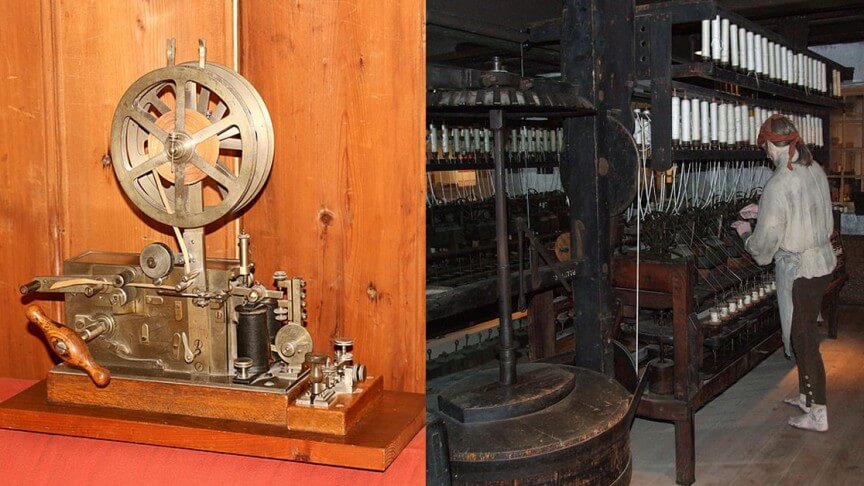
The Industrial Revolution was a period of rapid social and technological evolution and has a significant role in the transformation of the world as we know it today. It used to be a period of great innovation, and a lot of the items we see nowadays were inventions of the Industrial Revolution.
The 27 inventions you'll see below, are a hand-picked selection of some of the most significant inventions of the period as well as several of the lesser-known ones.
They vary from innovations within the textile industry to the iron industry and consumer goods of the later Industrial Revolution. We've limited our period between the mid-1700's and 1840 which is commonly known as the period of the Industrial Revolution.
1. Flying shuttle or weaving made easy

Flying Shuttle Loom, Weaver's Cottage Museum Source: Betty Longbottom/Wikimedia Commons
This excellent example was widely used throughout Lancashire after 1760 and was one of the most important developments of the period. It was patented in 1733 by John Kay, and its implementation efficiently doubled the output a weaver could make, thereby allowing the workforce to be halved efficiently.
Before this invention, a weaver was required on each side of a broad-cloth loom. Now one weaver alone could do the job. Several subsequent improvements were made to it over the years with a significant one in 1747.
Its impact was incredibly important, efficiently allowing production of textiles beyond the capacity of the rest of the industry. It arguably prompted further industrialization throughout the textile and other industries to keep up.
2. The Spinning Jenny increased wool mills productivity

Model Spinning Jenny, Museum of Early Industrialisation, Wuppertal, Germany Source: Markus Schweiß/Wikimedia Commons
The Spinning Jenny was another one of the great inventions of the Industrial Revolution. It was developed by James Hargreaves who patented his idea in 1764.
The Spinning Jenny was innovative for its time and one that would help change the world forever. It allowed workers to spin more wool at any one time.
That vastly raised mills productivity and, together with the Flying Shuttle, helped force further industrialization of the textile industry in the UK.
It allowed for a big reduction in the work needed to produce a piece of cloth and allowed for a worker to work eight or more spools at a time. With further refinement, that increased to 120 spools over time.
It has long been credited as the primary driver for the development of a modern factory system. By the time of Hargreaves's death in 1778, there were approximately 20,000 Spinning Jennys across the United Kingdom.
3. The Watt Steam Engine, the engine that changed the world
When James Watt created the first reliable steam engine in 1775, his invention would change the world. His innovation blew the older less efficient models, such as the Newcomen engine, out of the water.
James' innovation of adding a separate condenser, drastically improved steam engine efficiency, specifically latent heat losses. His new engine became popular and would wind up installed in mines and factories across the globe.
It was hands down, one of the most significant inventions of the Industrial Revolution.
His version also integrated a crankshaft and gears, and it became the prototype for all modern steam engines. It would eventually lead to unbelievable improvements in almost all industries, including the textile industry, across the Earth.
Steam engines would also lead to the development of locomotives and massive leaps forward in ship propulsion.
4. The Cotton Gin: the engine that made cotton production boom

Cotton Gin at Eli Whitney Museum. Source: Brighterorange/Wikimedia Commons
Eli Whitney is another name synonymous with inventions of the Industrial Revolution. He invented the cotton engine, gin for short, in 1794.
Before its introduction to the textile industry, cotton seeds needed to be removed from fibers by hand. That was laborious and time-consuming. The machine vastly improved the profitability of cotton for farmers.
The Cotton Gin enabled many more farmers to consider cotton as their main crop. That was vital for farmers and plantation owners in the Americas.
With the seeds and fibers separated more efficiently, it became much easier for farmers to use the fibers to make cotton goods like linen. They could also simultaneously separate seeds for more crop growth or the production of cottonseed oil.
5. Telegraph communications, a pillar of the Industrial Revolution

Hasler Electrical Telegraph Source: Hp.Baumeler/Wikimedia Commons
Coming in at the tail end of the Industrial Revolution, the Telegraph was one another of the most significant inventions of the Industrial Revolution. Created in the early 1800's it would change communication forever.
Thanks to that technology, near instant communication became possible at first across the country and eventually across the world. That enabled people to stay in contact and grow aware of wider geopolitical events much more efficiently.
The first real electrical telegraphs finally superseded optical semaphore telegraph systems to become the world's first electrical form of telecommunications. In only a matter of decades, the electrical telegraph became the de facto means of communication for business and private citizens long distance.
6. Portland Cement and the invention of concrete
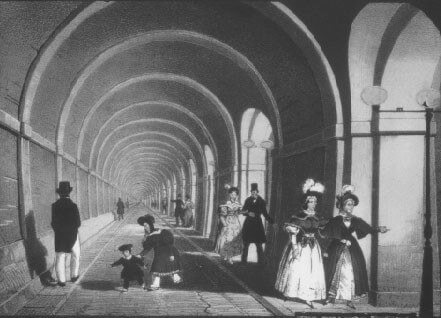
Interior of the Thames Foot Tunnel, mid-19th century. Source: Nichtbesserwisser/Wikimedia Commons
Joseph Aspdin was a bricklayer turned builder who, in 1824, devised and patented a chemical process for making Portland Cement. That one invention of the Industrial Revolution has been one of the most significant of all time for the construction industry.
His process involved sintering a mixture of clay and limestone to around 1,400-degree centigrade. That then needed to be ground into a fine power only to be later mixed with sand and gravel to make concrete.
Years later, Brunel would be used Portland Cement to help construct the Thames Tunnel. It was also used on a large scale in the construction of the London Sewage system and many other construction projects around the globe.
It was also one of the great inventions of the Industrial Revolution.
7. The modern roads by John McAdam
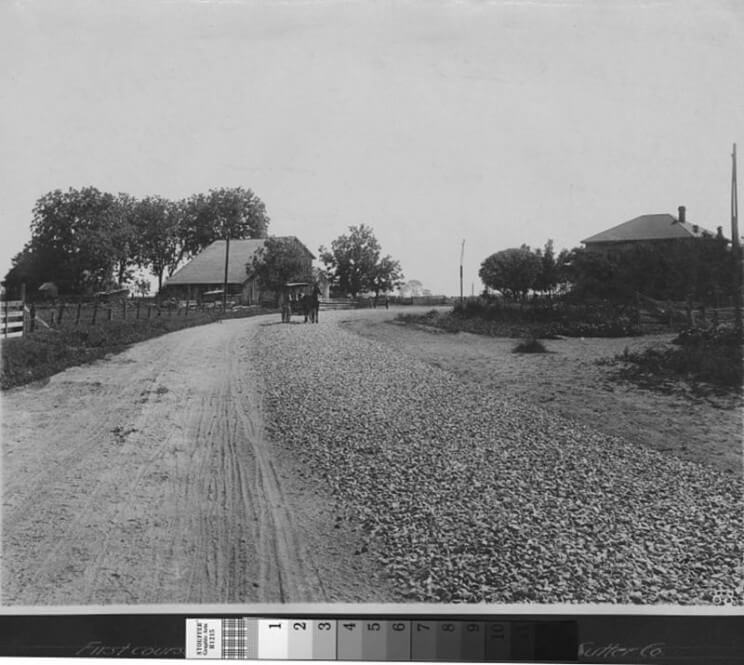
Example of Macadam Road in around 1850. Source: Sutter County Library/Wikimedia Commons
Before the Industrial Revolution, the quality of Britain's roads was less than good. At the time France was known to have the best quality ones worldwide.
Many British roads were poorly maintained and poor quality. During the 1700's turnpike trusts were set up to charge tolls in an effort to improve maintenance and the general condition of the country's transport system.
By 1750 almost every main road in England and Wales was the responsibility of a turnpike trust.
John McAdam would eventually develop a new road building technique that would revolutionize road construction forever. His 'macadamised' roads would prove to be the most significant advancement in road building since the Roman Empire thousands of years before.
8. The Bessemer process that changed steel

Bessemer converter at former ironworks, Hogbo, Sweden. Source: Calle Eklund/V-wolf/Wikimedia Commons
The Bessemer Process was the first inexpensive process for mass production of steel from molten pig iron worldwide. That would also prove to be one of the greatest inventions of the Industrial Revolution.
It's noted for its removal of impurities from the iron via oxidation as air is blown through the molten metal. Oxidation also helps increase the temperature of the iron mass to keep it molten for longer. The process is named after its inventor Henry Bessemer who patented the technique in 1856.
The ability to mass produce high-quality steel and iron allowed a literal boom in the use of them in many other aspects of the revolution. Iron and steel suddenly became essential materials and would be used to make almost everything from appliances to tools, machines, ships, buildings, and infrastructure.
9. The first modern Battery by Volta
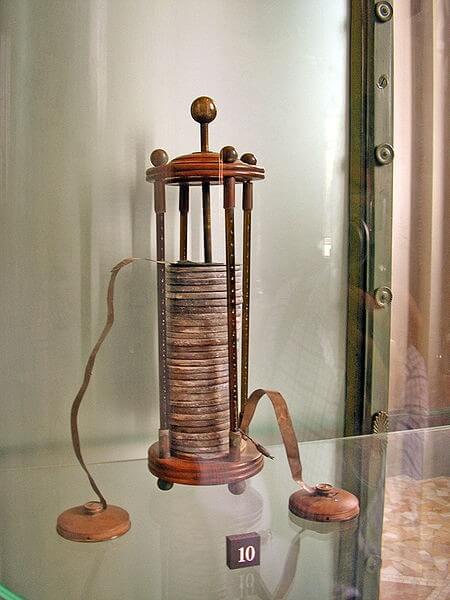
Volta's electric battery in Como, Italy. Source: GuidoB/Wikimedia Commons
Even though there's evidence of early batteries from the Parthian Empire about 2,000 years ago, the first true modern electric battery was invented in 1800. That world first was the brainchild of one Alessandro Volta with the development of his voltaic pile.
Mass production of the world's first battery started in 1802 by William Cruickshank.
The first rechargeable battery was invented in 1859 by the French physician Gaston Plante. Later advancements would lead to the Nickel-Cadmium battery being developed in 1899 by Waldemar Junger.
Volta's initial invention sparked a considerable amount of scientific excitement around the globe which would lead to the eventual development of the field of electrochemistry.
10. The Locomotive revolution
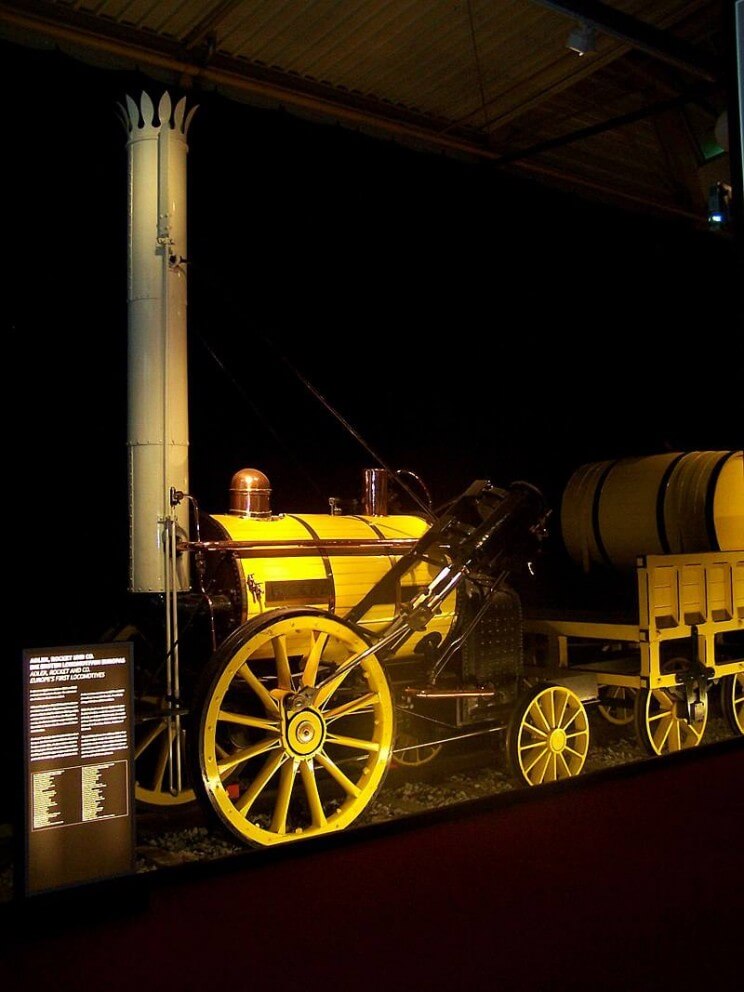
Replica of the "Rocket", Nuremberg Museum, Germany. Source: Urmelbeauftragter/Wikimedia Commons
The invention of the steam engine would eventually lead to a revolution in transportation around the globe. Locomotives allowed large-scale movement of resources and people over long distances.
Previously the industry relied on man- and animal- powered wagons and carts. Those were common all over Europe and were especially commonly associated with mining and agriculture.
After the pioneering work, Richard Trevithick in 1804 and of George Stephenson and his "Rocket" train networks would begin to spring up all over the UK and eventually the entire world.
The first public railway opened in 1825 between Stockton and Darlington in England. That would be the first of many railways and locomotives that would revolutionize the way business and private citizens transport their goods and themselves around.
11. The first factory opened by Lombe

Lombe's Manufactory/Mill, Derby circa 1770. Source: ClemRutter/Wikimedia Commons
One of the first, if not the first documented factory was opened by John Lombe in Derby around 1721. Lombe's factory used water power to help the factory mass produce silk products.
The factory was built on an island on the River Derwent in the English county of Derby. The idea for the factory came to Lombe after he had toured Italy looking at silk throwing machines.
On his return to the UK, he employed the services of the architect George Sorocold to design and build his new "Factory". Once completed the mill, at its height, employed around 300 people.
On its completion it was the first successful silk throwing mill in England and, it is believed, the first fully mechanized factory in the world. Lombe was granted a 14-year patent for his throwing machines only to die mysteriously in 1722. His death has been attributed to the King of Sardinia, who reacted badly to the commercialization of silk production in the United Kingdom.
12. The Power Loom, overtaking all United Kingdom factories
The invention of the Power Loom effectively increased the output of a worker by over a factor of 40. It was one of the most significant inventions of the Industrial Revolution.
It was introduced in 1874 by Edmund Cartwright who built the very first working machine in 1785. Over the following 47 years, the Power Loom was refined until it was made completely automated by Kenworthy and Bullough.
By 1850 there was approximately 260,000 Power Looms installed in factories all over the UK.
Cartwright's power loom was first licensed by Grimshaw of Manchester who built a small steam-powered weaving factory in 1790. Unfortunately, this soon burnt down. Initially, his looms were not a commercial success as they needed to be stopped to dress the warp.
That was soon addressed over the next few decades as he modified the design into a more reliable automated machine.
13. Arkwright's Water Frame spinning machine

A working example of Arkwright's water frame, Helmshore Mills Textile Museum. Source: ClemRutter/Wikimedia Commons
Richard Arkwright was a barber and wig maker who managed to devise a machine that could spin cotton fibers into yarn or thread very fast and easily. In 1760 he and John Kay produced a working machine. This prototype could spin four strands of cotton at the same time.
He would later patent his design in 1769. Further refinement of his design would ultimately allow the machine to spin 100's of strands at one time.
The spinning machine would go on to be installed in mills around Derbyshire and Lancashire where they were powered by waterwheels hence they were called water frames. Arkwright's machines alleviated the need for highly skills operators adding significant cost savings to mills that installed them.
14. The Spinning Mule: the yarn game-changer

Spinning Mule at Quarry Bank Mill. Source: Black Stripe/Wikimedia Commons
The Spinning Mule combines features of two earlier Industrial Revolution inventions: the Spinning Jenny and above-mentioned Water Frame. The Mule managed to produce a strong, fine and soft yarn that could be used in many kinds of textiles.
Nevertheless, it was best suited for the production of muslins. The Mule was devised by Samuel Crompton in 1775 who was too poor to actually patent his invention and so sold it to a Bolton manufacturer. The very first Mules were hand-operated but by the 1790's larger versions were driven by steam engines. These larger machines had as many as 400 spindles.
The Spinning Mule would become a trendy machine indeed and was installed in a large number of factories, but as he had relinquished his rights to the machine, Crompton would see none of the proceeds from the sales.
15. Henry Cort's puddling process
In 1784, Henry Cort succeeded in developing a method of converting pig iron into wrought iron by heating it and frequently stirring it in the presence of oxidizing substances. It was, at that time, the first method that allowed wrought ironed to be produced on a large scale.
Henry had managed to save a significant amount of capital during his ten-year service in the Royal Navy. With this money, he had bought an ironworks near Portsmouth in 1775.
By 1783 he obtained a patent for grooved rollers that would allow him to produce iron bars more quickly than the old method of hammering.
His puddling process would take the iron industry by storm, and over the next 20 years, British iron production quadrupled!
16. Gaslighting, lighting the streets of the modern world
Commercial gas lighting was first developed and introduced in 1792 by William Murdoch. Those early gas lights used coal gas, which was installed as lighting in his house in Redruth, Cornwall.
Over a decade later, German inventor Freidrich Winzer became the first person to patent the use of coal gas for lighting in 1804. A thermo-lamp was also developed in 1799 using gas distilled from wood, and David Melville received the first patent in the United States for gas lighting in 1810.
After its development, gas lighting became the method of street lighting across the US and Europe. These would eventually be replaced with low-pressure sodium or high-pressure mercury lighting in the 1930's.
17. 2,000 cell to create the first Arc Lamp
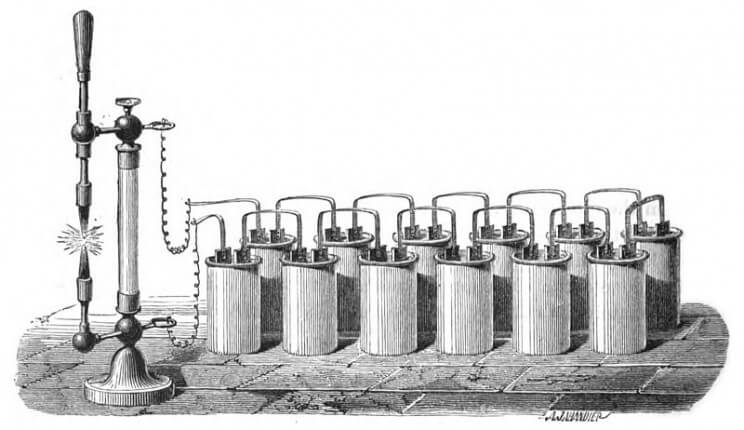
Davy's Arc Lamp and battery Source: Chetvorno/Wikimedia Commons
Sir Humphrey Davy was able to build the first arc lamp worldwide in 1807. His device used a battery of 2,000 cells to create a 100mm arc between two charcoal sticks.
As fascinating as his initial success, it wasn't a practical piece of equipment until the development of electrical generators in the 1870's. Arc lamps are still in use today in applications such as searchlights, large film projectors, and floodlights.
The term is mostly limited to lamps with an air gap between consumable carbon electrodes. However, fluorescent and other electric discharge lamps generate light from arcs in gas-filled tubes. Several ultraviolet lamps are of the arc type.
18. The Tin Can, jumping to new production heights

Source: Chris Potter/Wikimedia Commons
The humble tin can was patented by a British merchant Peter Durand in 1810. It would have an incalculable impact on food preservation and transportation right up to the present day.
John Hall and Bryan Dorkin would open the very first commercial canning factory in England in 1813. In 1846, Henry Evans invented the machine that can manufacture tin cans at a rate of sixty per hour.
That was a significant increase over the previous rate of only six per hour.
The very first tin cans had very thick walls and needed to be opened using a hammer. Over time they became thinner enabling the later invention of a dedicated can opener in 1858.
It took the American Civil War to inspire the creation of tin cans with a key can opener as can still be found on sardine cans.
19. Spectrometer, or how we studied glowing objects

Joseph von Fraunhofer demonstrating the spectroscope. Source: Richard Wimmer/Wikimedia Commons
In 1814, a German inventor, Joseph von Fraunhofer invented the spectrometer. His early device was devised to enable the chemical analysis of glowing objects.
Little did Joseph know the full impact his invention would have on the scientific world. We can owe the fact that we know what the Sun is made of thanks to Fraunhofer.
Thanks to Fraunhofer’s contributions, Bavaria overtook England as the leader in optics research. He invented the spectroscope in 1814.
In fact, his discoveries earned him a knighthood in 1824, two years before his death. Like all glassmakers of the time, he died early because of heavy metal poisoning.
20. Camera Obscura: The first photograph

World's first photograph by Joseph Niepce Source: Joanjoc~commonswiki/Wikimedia Commons
In 1814, Joseph Nicéphore Niépce began a journey of discovery that would eventually lead him to become the first person to ever take a photograph. He'd eventually do that using his new-fangled camera obscura that was set up in the windows of his home in France.
The entire exposure took around eight hours to capture the picture.
Joseph constructed his first camera in around 1816 which allowed him to create an image on white paper. But he couldn't fix it.
He would continue his experimentation using different cameras and chemical combinations for the next ten years or so.
In 1827 he successfully produced the first, long-lasting image using a plate coated with bitumen. That was then washed in a solvent and placed over a box of iodine to produce a plate with light and dark qualities.
21. The first Electromagnet findings
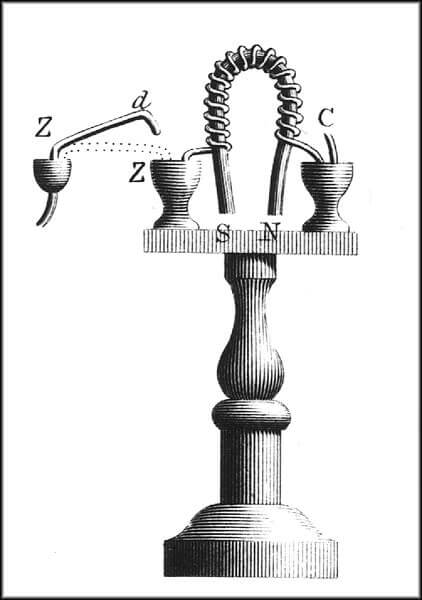
Sturgeon's electromagnet. Source: Chetvorno/Wikimedia Commons
The electromagnet was the culmination of a series of developments from Hans Christian Oersted, Andre-Marie Ampere, and Dominique Francois Jean Arago made their critical discoveries on electromagnetism.
One man, William Sturgeon, took the findings of these brilliant scientists and built on them to build the world's first electromagnet.
He discovered that leaving some iron inside a coil of wire would vastly raise the magnetic field created. He also realized that by bending the iron into a u-shape, allowed the poles to come closer together, thereby concentrating the field lines.
His design was improved upon by Joseph Henry who built, in 1832, a very strong electromagnet that could lift 1630 kgs.
22. The Mackintosh Raincoat
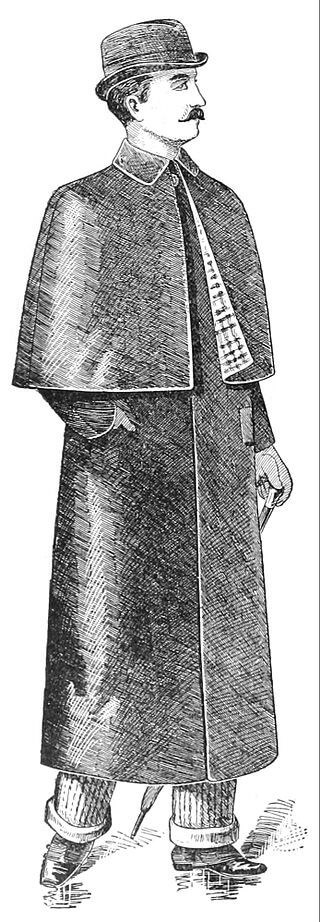
The Mackintosh, Circa 1893. Source: Cbaile19 /Wikimedia Commons
Maybe one of the most useful of all inventions during the Industrial Revolution was when, in 1823, Charles Mackintosh devised the Mackintosh. Before his invention clothing was waterproofed by using a coating of rubber.
However, rubber would become sticky and tacky during hot weather and extremely stiff during winter months. Charles, a Scottish Chemist, successfully cured that problem and patented a new method of using rubber to waterproof clothing.
Initially, he created his new waterproof clothing at his family's textile factory. By 1843, Mackintosh had started mass production of their clothes and merged with a larger clothing manufacturing company.
His method of waterproofing is known to us today as vulcanization. This process allowed the rubber to maintain its shape and not become sticky during hot weather such as natural rubber.
Mackintosh's design also placed the rubber covering inside two pieces of fabric rather than covering one.
23. Modern Friction Matches made possible with wood

In 1826, John Walker gave the world the first modern matches. Early efforts to make a match which produced ignition through friction, were made by Francois Derosne in 1816.
However, these were crude, and used sulfur tipped match to scrape inside a tube coated with phosphorus. That was both inconvenient and unsafe. Waker was a Chemist and druggist from Stockton-on-Tees who developed a keen interest in trying to make fire as easily as possible.
Chemical combinations were known to provide sudden ignition, but what had not been finalized was a means of transmitting the flame to a slow-burning material such as wood.
When, quite by accident, a prepared match ignited by accident from friction on the hearth he at once knew he had found the answer. He immediately set about producing wooden splints or stick of cardboard and coating them with sulfur.
He then added a tip with a mixture of a sulfide of antimony, chlorate of potash and gum. Camphor was added later to mask the smell of the sulfur once ignited.
24. Every great writer's companion, the Typewriter

Burt's Typographer. Source: Flickr/Wikimedia Commons
It's widely accepted that in 1829, William Austin Burt patented the "first typewriter" which he termed a "Typographer". There were earlier machines similar in purpose, a notable example being Henry Mill's 1714 patent, but it seems they have never been capitalized upon.
The Science Museum in London describes Burt's machine as the "the first writing mechanism whose invention was documented". Despite its apparent breaking of new ground, contemporary sources indicated that even when used by Burt the machine was slower than handwriting.
That was because the typographer needed to use a dial rather than keys to select each character.
The lack of efficiency improvement over handwriting ultimately sealed Burt's machine's doom. Both he and its promotor John D. Sheldon never found a buyer for the patent.
The modern typewriter would ultimately be invented in 1867 by Christopher Sholes.
25. The Dynamo powered by the Faraday principle
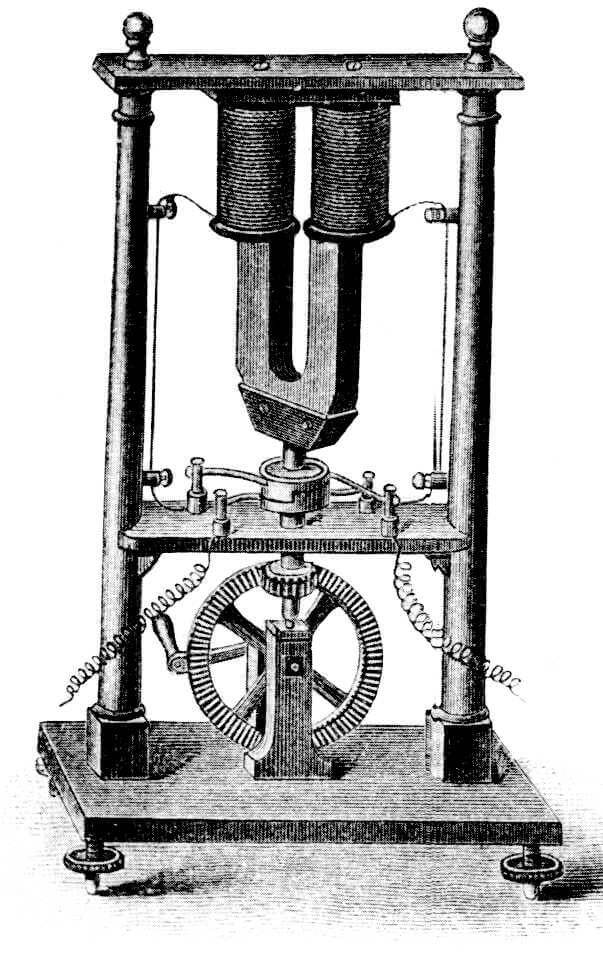
Hippolyte Pixii's Dynamo. Source: DMahalko/Wikimedia Commons
Here is another great invention of the Industrial Revolution. The basic principles of electromagnetic generators were found in the early 1830's by Michael Faraday.
Faraday noted that electromotive force is generated when an electrical conductor encircles a varying magnetic flux. That would later become known as Faraday's Law.
Michael also built the first electromagnetic generator, the Faraday Disk. That was a type of homopolar generator that used a copper disc that rotated between the poles of a horseshoe magnet.
The first true dynamo, based on Faraday's principle, was built in 1832 by Hippolyte Pixii, a French instrument maker. His device used a permanent magnet that was rotated using a crank.
26. Blueprints from Herschel and Poitevin

Source: Adrian Michael/Wikimedia Commons
John Herschel, a British scientist, and inventor succeeded in developing the process that was the direct precursor to what we now know as blueprints. John made improvements in photographic processes, especially in inventing the cyanotype process and variations (such as the chrysotype), the precursors of the modern blueprint process in around 1839.
That process enabled the production of a photograph on glass; he also experimented with some color reproduction. It is also believed that he coined the term photography.
It wasn't until 1861 that 'true' blueprints were developed by Alphonse Louis Poitevin, A French Chemist. He discovered that Ferro-gallate in gum is light sensitive.
When exposed to light, it turns into an insoluble permanent blue. He successfully postulated that a coating of this on paper or other material could be used to copy an image from another translucent document.
Who would have thought that this was one of the inventions of the Industrial Revolution?
27. The Hydrogen Fuel Cell

Grove's 1842 sketch of a Fuel
Last but by no means least on this list of inventions of the Industrial Revolution is one you might not expect. The Hydrogen Fuel Cell was first documented in 1838, in a letter published in the December edition of The London and Edinburgh Philosophical Magazine and Journal of Science.
The piece was written by a Welsh physicist and barrister William Grove. In it, he described his development of a crude fuel cell that combined sheet iron, copper and porcelain plates and a solution of sulfate of copper and dilute acid.
In the same publication published one year later, a German physicist Christain Freidrich Schonbein, also discussed his crude fuel cell that he believed he had invented. His letter described how current was generated using hydrogen and oxygen dissolved in water.
Grove sketched his design later in 1842, once again, for the same journal. Both of these used similar materials to days phosphoric acid fuel cells.
References: Interesting Engineering, ThoughtCo, BrightHub












Impressive how far we've come. I also recommend you to get acquainted with this content.
ReplyDeleteYour article gives me another approach on the subject. Very good. This message is first-class.
ReplyDeleteReviews of Hotels